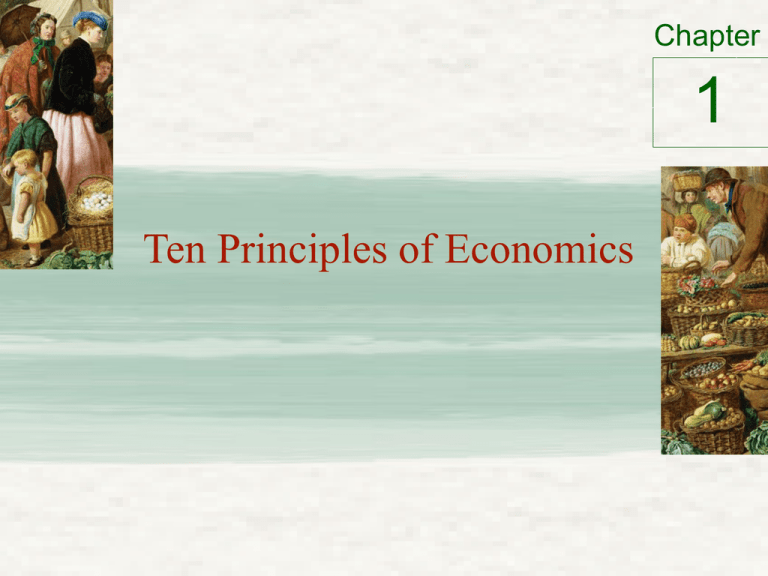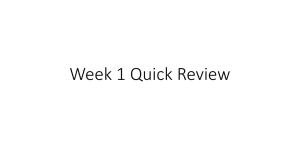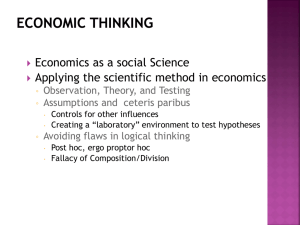1 Ten Principles of Economics Chapter
advertisement

Chapter 1 Ten Principles of Economics Key Terms • Common understanding of key terms – Use them as shorthand for the concept; but have a precise/exact meaning • Scarcity – There are not enough resources to produce and consume all of the goods and services we desire • Opportunity costs – What must be given up (next best alternative use) as a result of a decision or choice – “No such thing as a free lunch” (Milton Friedman) • Cost-benefit analysis – Every decision/action has tradeoffs How People Make Decisions Principle 1: People face trade-offs • Making decisions – Trade off one goal against another • Student – time (sleeping versus studying) • Parents – income (consume or save) • National defense vs. consumer goods • Clean environment vs. high level of income • Efficiency vs. equality 3 How People Make Decisions Principle 1: People face trade-offs (examples) • Efficiency – Society - maximum benefits from its scarce resources – Size and distribution of the economic pie (national income and distribution) • Equality – Benefits - uniformly distributed among society’s members – How the pie is divided into individual slices 4 How People Make Decisions Principle 2: The cost of something is what you give up to get it • Because people face trade-offs when making choices – you have to give something up to get something – Benefit/Cost Analysis to make decisions • Compare cost with benefits of alternatives • Implies and opportunity cost is incurred – Whatever most be given up to obtain one item 5 How People Make Decisions Principle 3: Rational people think at the margin • Rational people – Systematically & purposefully do the best they can to achieve their objectives • Rational decision maker – take action only if – Marginal benefits > Marginal costs • Marginal Benefits – change (or increase) in total benefits from choice • Marginal Costs – change/increase in costs from choice (opportunity costs of “not chosen”) 6 3. Optimal decisions are made at the “margin” • What do we mean? – When making an economic decision, e.g. to purchase 1 more unit of a good, we compare the marginal (or incremental) benefits against the marginal costs • For example – When studying for an exam • Given you’ve already studied 8 hours, when deciding whether or not to study 1 more hour, you compare – the expected benefits (a “marginal” improvement in your grade – Versus the next best (highest valued) use of your time » E.g., sleeping, eating, time with friends Marginal Decisions • Back to the First Law of Demand – How much of a good do you buy? • If the marginal/incremental value of the next unit is less than what it costs, are you willing to buy it? MV < price Don’t buy! MV < price Do buy! How People Make Decisions Principle 4: People respond to incentives • Incentive – Something that induces a person to act – Higher price • Buyers - consume less • Sellers - produce more – Public policy • Change costs or benefits • Change people’s behavior 9 • An example: the First Law of Demand – As the price per unit of the good declines, a consumer (all other things held constant, e.g. their income) will choose to buy more of the good over the same time period How People Make Decisions Principle 4: People respond to incentives – Gasoline tax • Car size & fuel efficiency; carpool; public transportation – Unintended consequences • Policymakers fail to consider how their policies affect incentives 11 Learning Objective 1.1 Making the Connection •Will Women Have More Babies if the Government Pays Them To? The Estonian government is encouraged by the results of providing economic incentives and is looking for ways to provide additional incentives to raise the birthrate further. How People Interact Principle 5: Trade can make everyone better off • Trade – Specialization • Allows each person/country to specialize in the activities he/she does best – People/countries can buy a greater variety of goods and services at lower cost 13 A Parable for the Modern Economy • Two goods: meat and potatoes • Two people: rancher and farmer • If rancher produces only meat – And farmer produces only potatoes – Both gain from trade • If both rancher and farmer produce both meat and potatoes – They still gain from specialization and trade 14 1 The production possibilities frontier (a) (a) Production Opportunities Minutes needed to Make 1 ounce of: Farmer Rancher Amount produced in 8 hours Meat Potatoes Meat Potatoes 60 min/oz 20 min/oz 15 min/oz 10 min/oz 8 oz 24 oz 32 oz 48 oz Panel (a) shows the production opportunities available to the farmer and the rancher. 15 1 The production possibilities frontier (b, c) (b) The farmer’s production Meat (oz) possibilities frontier If there is no trade, the farmer chooses this production and consumption. (c) The rancher’s production Meat (oz) possibilities frontier 24 8 12 4 0 If there is no trade, the rancher chooses this production and consumption. B A 16 Potatoes (oz) 32 0 24 48 Potatoes (oz) Panel (b) shows the combinations of meat and potatoes that the farmer can produce. Panel (c) shows the combinations of meat and potatoes that the rancher can produce. Both production possibilities frontiers are derived assuming that the farmer and rancher each work 8 hours per day. If there is no trade, each person’s production possibilities frontier is also his or her consumption possibilities frontier 16 1 The opportunity cost of meat and potatoes Opportunity cost of: Farmer Rancher 1 oz of Meat 1 oz of Potatoes 4 oz potatoes 2 oz potatoes ¼ oz meat ½ oz meat 17 A Parable for the Modern Economy • Specialization and trade – Farmer – specialize in growing potatoes • More time growing potatoes • Less time raising cattle – Rancher – specialize in raising cattle • More time raising cattle • Less time growing potatoes – Trade • Willing to trade: 3 oz of meat for 1 oz potatoes • Final trade -5 oz of meat for 15 oz of potatoes 18 Farmer’s Gains From Trade Farmer Potatoes Meat No Trade With 32 32 0 28 29 1 24 26 2 20 23 3 16 20 4 12 17 5 8 14 6 4 11 7 0 8 8 35 30 25 20 Taters - No Trade 15 Taters - Trade 10 5 0 0 1 2 3 4 5 6 7 8 19 Rancher’s Gains From Trade 80 70 60 50 Taters - No Trade 40 Taters - Trade 30 20 10 0 24 22 20 18 16 14 12 10 8 6 4 2 0 20 2 Greg’s Final Solution (text) (a) The farmer’s production Meat (oz) and consumption Farmer's production and consumption without trade 8 Farmer's consumption with trade 0 A 16 17 Farmer's production with trade 32 18 B* 13 12 0 Rancher’s production and consumption without trade Rancher’s production with trade 24 A* 5 4 (b) The rancher’s production Meat (oz) and consumption Rancher’s consumption with trade B 12 27 24 48 Potatoes (oz) Potatoes (oz) Farmer and Rancher agree to trade 5 oz of Meat for 15 oz of Potatoes (3:1) Start at corners (specialization) 21 Comparative Advantage • Absolute advantage – Produce a good using fewer inputs than another producer – Rancher: 20 min/1 oz M; 10 min/1 oz P – Farmer: 60 min/ 1 oz M; 15 min/ 1 oz P • Opportunity cost – Measures the trade-off between the two goods that each producer faces – Rancher -1 oz M -> 2 oz P – Farmer: 3 oz P -> -1 oz M 22 How People Interact Principle 7: Governments can sometimes improve market outcomes • Government intervention – Change allocation of resources – To promote efficiency • Avoid market failure – To promote equality • Avoid disparities in economic wellbeing 23 How People Interact • Market failure – Situation in which the market on its own fails to produce an efficient allocation of resources • Causes for market failure – Externality • Impact of one person’s actions on the well-being of a bystander – Market power • Ability of a single person (or small group) to unduly influence market prices 24 Table 1 Ten principles of economics How People Make Decisions 1: People Face Trade-offs 2: The Cost of Something Is What You Give Up to Get It 3: Rational People Think at the Margin 4: People Respond to Incentives How People Interact 5: Trade Can Make Everyone Better Off 6: Markets Are Usually a Good Way to Organize Economic Activity 7: Governments Can Sometimes Improve Market Outcomes How the Economy as a Whole Works 8: A Country’s Standard of Living Depends on Its Ability to Produce Goods and Services 9: Prices Rise When the Government Prints Too Much Money 10: Society Faces a Short-Run Trade-off between Inflation and Unemployment 25



